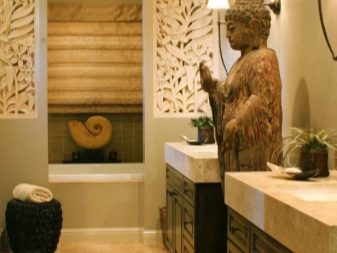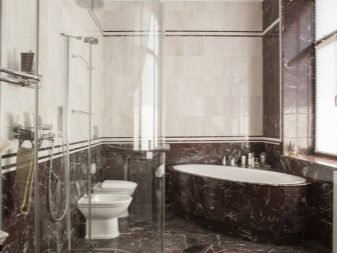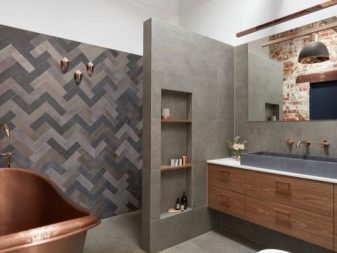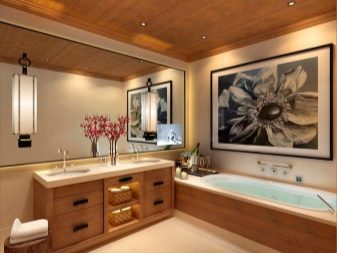Large bathrooms: examples of exclusive interiors

Large bathrooms open up incredible opportunities for imagination in design, but do not forget that this room, first of all, should be functional. Therefore, starting the arrangement of a spacious bathroom, you should carefully approach the layout, think over to the smallest detail the features of the room, the location of communications, the overall picture of the interior.


Layout
The owners of spacious bathrooms are not burdened with the need to save square meters of space. In a large room, you do not need to think about whether the sink will fit into a cramped room, in which corner to put the washing machine, where to organize a place for household goods and linen. But large bathrooms can be fraught with difficulties.


In order not to subsequently face the problem of empty or, conversely, overloaded with interior items, you need to pre-allocate the main functional areas.
- space for water procedures - consists of a basic set of plumbing: bath, sink, shower, toilet (if the bathroom is combined);
- relaxation area - includes furniture for relaxation and beauty treatments, mirrors, space for clothes, towels and bathrobes;
- working area - contains household appliances, cabinets and boxes for bath accessories and household goods, laundry baskets.



Style solutions
The choice of style for a spacious bathroom is entirely up to personal preference. You can create a sketch of the design yourself or ask the professionals for help.
Designers advise decorating the bathroom in the same style as the entire room., but this is not necessary at all. However, it should be borne in mind that a radical design contrast in different rooms is undesirable. For example, if the interior of the apartment is made in a strict classical style, and the bathroom has bright features of high-tech or country style, this will inevitably cause dissonance of perception.




When choosing a design for a bathroom - with all the variety of styles - it is convenient to start from several opposite style directions. The styles described below are best suited for water-related environments.





Classic
This style is based on a combination of austerity of lines and monumentality of execution. A classic-style bathroom is an emphasized luxury of furniture made from natural materials, a king-size bathtub, columns and moldings in the interior design. The classic antique style is characterized by marble-like wall and floor cladding, mirrors in heavy frames, a crystal chandelier and lamps in the form of candelabra.




Calm deep tones of natural shades prevail. The dark vanity tops and vanity tables made of noble wood go well with the bathtub, bedside tables and shelves made in pearl or ivory.
Gilding on wrought metal of patterned legs and decorative elements will add a touch of baroque luxury to the interior.


Minimalism
The predominant style in the modern era of high speed and technology. It is for those who are not inclined to overload the space with decorative trifles and prefer functionality and space.In a minimalist interior, all items have their own functional purpose, the amount of furniture is minimal, but there can be a lot of modern plumbing equipment: a jacuzzi, a shower cubicle, an installed toilet bowl and bidet.


The color scheme is neutral, with a predominance of one or two shades. Multilevel lighting allows you to create spot lighting over each functional area of the room.
The minimalist style often overlaps with other contemporary styles. So, a combination with a futuristic high-tech style will bring interesting notes to the interior, fill the space with fashionable achievements of modern technologies, unusual finishing elements made of glass, plastic or metal.




Mediterranean country
Of all the areas of rustic style, Mediterranean country is the most suitable for the bathroom. This style most fully reflects the marine theme, goes well with 3D drawings on ceramic tiles, with decorative elements in the form of seashells, corals, beach sand or pebbles under glass countertops. The predominance of white, blue and sand shades will refresh the room, fill it with the air of distant beaches. Dolphins, seascapes, palm trees on the walls will create an atmosphere of rest and relaxation.




Ethno
Ethnic design is suitable for lovers of exotic. The style differs from the national color of country music in that it includes larger layers of national culture. Any of the ethno-styles immerses as much as possible into the atmosphere of a certain exotic country. This can be a Chinese-style bathroom with painted surfaces, hieroglyphs and dragons on the walls, sconces in the form of red Chinese lanterns, a dressing screen with Chinese paintings.





Indian flavor is emphasized by images of Buddha, elephant figurines and heavy floor vases, an abundance of bright colors and gold. The atmosphere of Ancient Egypt will be conveyed by sand colors, gilded objects, embossed plaster on the walls and ceiling with images of Egyptian symbols and gods.




Fusion
For fans of mixing styles, there is a great way out - the style direction of fusion.
A natural and harmonious mix in the interior is the main feature of the style. When mixing different styles, the main rule of the fusion style is to maintain a sense of proportion and simplicity. Here, seemingly incompatible objects of different eras and trends, clear geometric lines with intricate lurid shapes, expensive woods with emphasized simple plastic or glass, coexist here.


The style is characterized by bright colors of pink, turquoise and purple hues. Intersperses in this range of gold, black and white colors are not alien either. Animalistic patterns are welcome: zebra, leopard, exotic jungle floral ornament.
Among other things, the style gravitates towards objects of different eras and trends. An expensive floor vase can be adjacent to brickwork or rattan furniture. A cosmetic table on wrought iron legs with a glass top can be complemented by bright acrylic chairs.




Decoration Materials
The choice of finishing materials for large bathrooms is quite wide. Moreover, designers often use a combination of various types of cladding to give the greatest aesthetics to the room. The combination of elements of different texture and color allows you to create the most beautiful and original images of the interior.


Ceramic tile
Ceramics are one of the most popular bathroom finishes. It is perfect for rooms with high humidity, has sufficient strength, unpretentious operation, easy to install and maintain. In the modern building materials market, you can choose ceramic tiles of any shade, as well as suitable for the most exotic interior style.Ceramics can also be used as part of the cladding where moisture gets the most. For example, aprons over the bathtub or sink, the wall of the shower stall.


Mosaic ceramics
Finishing material made of small ceramic pieces on a grid is the most convenient option for cladding and decorating hard-to-reach areas of the bathroom. In addition, the mosaic pattern gives the surface relief and color saturation. Mosaic modules can be used to decorate niches, columns, protrusions with irregular geometry and curved ducts for plumbing. The mosaic pattern will look beautiful in the form of a panel with a ready-made pattern or as a frame around mirrors, borders along the walls.


Marble
The most expensive natural material, but at the same time the most luxurious and durable. Looks respectable in spacious bathrooms in classic antique style or minimalism style. But the full marble cladding will not always be justified from an aesthetic point of view, not to mention the financial side of such investments. Natural material carries a museum coldness and does not tolerate negligence in the interior.
Having chosen such a high bar, you will have to match the noble material in all other items of the bathroom interior. The option of partial use of marble to decorate and accentuate certain areas of the room will be much more comfortable and cheaper. This can be a part of the wall near the shower, the floor under the luxury bath or Jacuzzi, steps to the bath pedestal, if there is one in the project.


Porcelain stoneware
Basically, this material is used for flooring or individual parts of the walls. Strong and durable porcelain stoneware is resistant even to severe mechanical damage, simple and unpretentious in maintenance.
Correctly selected tones of the material can decorate any interior, but it looks especially good in rough rustic or loft styles.




Decorative plaster
There is an opinion that decorative plaster is not suitable for rooms with high humidity and constant temperature changes. But not so long ago, a special type of acrylic-based plaster appeared on the market of finishing materials. It is resistant to hot air, easily tolerates fumes, absorbs and releases moisture when dry. Thanks to this property, a special microclimate is formed in the bathroom, which does not allow condensation to collect and fog up the mirrors, as well as prevents the appearance of fungus on the walls.


Decorative plaster is a material with which you can create an original room design: relief patterns, abstract paintings, imitation of natural stone, wood, rough surface. Particularly popular are stencil or volumetric drawings on plaster, as well as the effect of patination (artificial aging). Acrylic plaster is durable and can be easily cleaned with conventional detergents.



The choice of plumbing
Long gone are the days when baths, sinks and toilets were standard and only occasionally had some differences in materials and colors. Modern plumbing production offers a huge selection of items in a wide variety of shapes, structures and colors. Today, you can choose plumbing items of various price ranges to match the style of the bathroom: from relatively inexpensive porcelain and faience, acrylic and steel to luxury items made of marble and natural stone, vintage cast iron and extravagant wood.

The most common material is acrylic. - durable reinforced plastic, lightweight and resistant to mechanical damage. Good heat-saving properties of acrylic and low specific gravity were appreciated by manufacturers and then by consumers of modern sanitary ware.
Plumbing models made of wood and natural stone are quite expensive and in most cases are made to order.The cheapest option is stainless steel. The material is lightweight, does not hold heat well and does not hide the noise of water.


A standard plumbing set includes the following items:
- bathroom;
- sink;
- toilet bowl;
- shower cabin.
In some cases, the set can be supplemented with auxiliary elements: bidets, urinals.
Depending on the models, bathtubs and shower cabins can be equipped with LED lighting, hydromassage mechanisms, and ergonomic devices.



Furniture
The choice of pieces of furniture will directly depend on the style of the bathroom, but in any case, it should be comfortable, functional and not overload the space.
A spacious room can harmoniously accommodate bedside tables and glass racks for cosmetics, wardrobes for bathing accessories, closed boxes for laundry, hangers for clothes and wet towels, and, of course, upholstered furniture for relaxation: sofas, ottomans, low tables.


It is preferable to choose the upholstery of upholstered furniture from hydroskin or materials that are resistant to wetting. The set, selected in the same design and color scheme, will add sophistication and harmony to the bathroom. If in a private house there is a bathroom with a window, then curtains or blinds to match the furniture will emphasize the unity of the entire composition of the interior.


For information on how to choose bathroom fixtures, see the next video.













The comment was sent successfully.